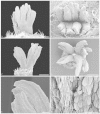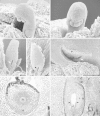Female flower and cupule structure in Balanopaceae, an enigmatic rosid family
- PMID: 12930731
- PMCID: PMC4257519
- DOI: 10.1093/aob/mcg158
Female flower and cupule structure in Balanopaceae, an enigmatic rosid family
Abstract
The Balanopaceae, whose flowers were poorly known, have, in the past, been variously allocated to the Fagales, Euphorbiaceae, Salicales or other hamamelids and rosids (these groups being in Fagales, Malpighiales and Saxifragales, according to the Angiosperm Phylogeny Group). This paper attempts a clarification based on flower morphology. Female flowers and cupules were studied in Balanops vieillardii, young fruits in B. australiana. The cupules are simple involucres of bracts which are spirally arranged (according to a Fibonacci pattern) on the floral axis preceding the flower. They contrast with the complicated cupules of Fagaceae which consist of a condensed cymose ramification system of axes of several orders around the flower. Flowers appear later than most of the cupular bracts, in contrast to Fagaceae. In addition to a terminal flower there may be several smaller lateral flowers in the axil of cupular bracts, each surrounded by its own small cupule. The female flowers do not have a perianth. They consist of two to three large carpels. At anthesis, the ovary is completely septate; the syncarpous part (ovary and lower style) is completely symplicate. The carpels are free for most of their length, with the free parts once, twice or three times bifurcate, in contrast to simple in Fagales. The stigmatic surface covers the ventral side of each stigmatic branch and at the margins also spreads to the dorsal side. The stigma is wet and secretion appears holocrine. The two ovules per carpel are collateral and axile in early development. However, at anthesis they appear one above the other, because in one ovule the funicle greatly elongates. As the ovary elongates only above the placenta, the ovules appear basal at anthesis. The ovules are (weakly) crassinucellar, bitegmic (not unitegmic), anatropous, and intermediate between apotropous and epitropous (not apotropous). The ovules are mature at anthesis, in contrast to Fagales. In mature ovules the upper part of the nucellus disintegrates, and a weakly differentiated endothelium is present in the inner integument. The morphological results of this study support a position of Balanopaceae in Malpighiales, and not Fagales or other orders, and are thus in accordance with recent molecular results based on chloroplast rbcL sequences data. However, within Malpighiales, as opposed to molecular results, Balanopaceae agree more with Euphorbiaceae s.l. than with Dichapetalaceae/Trigoniaceae and Chrysobalanaceae/Euphroniaceae.
Figures








Similar articles
-
Advances in the floral structural characterization of the major subclades of Malpighiales, one of the largest orders of flowering plants.Ann Bot. 2013 May;111(5):969-85. doi: 10.1093/aob/mct056. Epub 2013 Mar 13. Ann Bot. 2013. PMID: 23486341 Free PMC article. Review.
-
Floral structure of Emmotum (Icacinaceae sensu stricto or Emmotaceae), a phylogenetically isolated genus of lamiids with a unique pseudotrimerous gynoecium, bitegmic ovules and monosporangiate thecae.Ann Bot. 2014 Oct;114(5):945-59. doi: 10.1093/aob/mcu166. Epub 2014 Aug 19. Ann Bot. 2014. PMID: 25139428 Free PMC article.
-
Verhuellia is a segregate lineage in Piperaceae: more evidence from flower, fruit and pollen morphology, anatomy and development.Ann Bot. 2010 May;105(5):677-88. doi: 10.1093/aob/mcq031. Epub 2010 Mar 17. Ann Bot. 2010. PMID: 20237114 Free PMC article.
-
Carpels in Brasenia (Cabombaceae) are completely ascidiate despite a long stigmatic crest.Ann Bot. 2005 Aug;96(2):209-15. doi: 10.1093/aob/mci174. Epub 2005 May 31. Ann Bot. 2005. PMID: 15928008 Free PMC article.
-
[Morphological and molecular data on the origin of angiosperms: on a way to a synthesis].Zh Obshch Biol. 2007 Mar-Apr;68(2):83-97. Zh Obshch Biol. 2007. PMID: 17484150 Review. Russian.
Cited by
-
Embryology of the Irvingiaceae, a family with uncertain relationships among the Malpighiales.J Plant Res. 2011 Sep;124(5):577-91. doi: 10.1007/s10265-010-0393-7. Epub 2010 Nov 30. J Plant Res. 2011. PMID: 21116833
-
Floral morphology and development in Quillajaceae and Surianaceae (Fabales), the species-poor relatives of Leguminosae and Polygalaceae.Ann Bot. 2007 Dec;100(7):1491-505. doi: 10.1093/aob/mcm228. Epub 2007 Sep 29. Ann Bot. 2007. Corrected and republished in: Ann Bot. 2008 Jun;101(9):1433, 1491-505. doi: 10.1093/aob/mcn073. PMID: 17906327 Free PMC article. Corrected and republished.
-
Advances in the floral structural characterization of the major subclades of Malpighiales, one of the largest orders of flowering plants.Ann Bot. 2013 May;111(5):969-85. doi: 10.1093/aob/mct056. Epub 2013 Mar 13. Ann Bot. 2013. PMID: 23486341 Free PMC article. Review.
-
Floral morphology and development in Quillajaceae and Surianaceae (Fabales), the species-poor relatives of Leguminosae and Polygalaceae.Ann Bot. 2008 Jun;101(9):1433, 1491-505. doi: 10.1093/aob/mcn073. Ann Bot. 2008. PMID: 18494144 Free PMC article.
-
Mitochondrial matR sequences help to resolve deep phylogenetic relationships in rosids.BMC Evol Biol. 2007 Nov 10;7:217. doi: 10.1186/1471-2148-7-217. BMC Evol Biol. 2007. PMID: 17996110 Free PMC article.
References
-
- APG(The Angiosperm Phylogeny Group).1998. An ordinal classification for the families of flowering plants. Annals of the Missouri Botanical Garden 85: 531–553.
-
- BaillonH.1871. Sur deux nouveaux genres apétales. Adansonia 10: 112–119.
-
- BaillonH.1872. Stirpes exoticae novae (continué). Adansonia 10: 334–345.
-
- BaillonH.1877.Histoire des plantes VI. Paris: Hachette.
-
- BenthamG.1880. Balanopseae. In: Bentham G, Hooker JD, eds. Genera plantarum, Vol. 3. London: Reeve, 341.
MeSH terms
LinkOut - more resources
Full Text Sources
Research Materials
Miscellaneous

